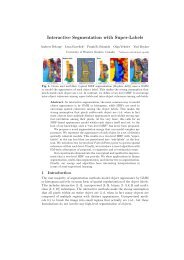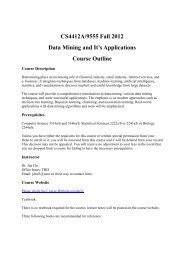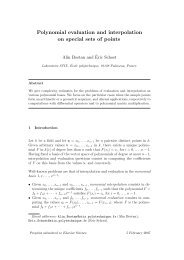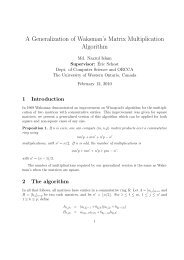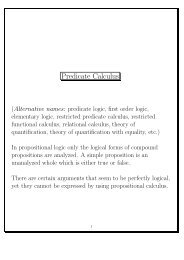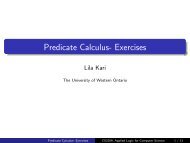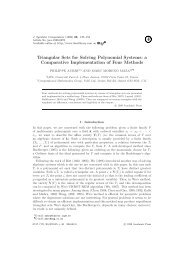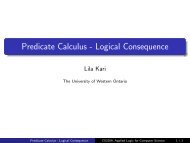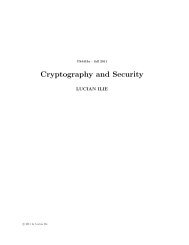Predicate Calculus - Computer Science - University of Western Ontario
Predicate Calculus - Computer Science - University of Western Ontario
Predicate Calculus - Computer Science - University of Western Ontario
You also want an ePaper? Increase the reach of your titles
YUMPU automatically turns print PDFs into web optimized ePapers that Google loves.
<strong>Predicate</strong> <strong>Calculus</strong>Lila KariThe <strong>University</strong> <strong>of</strong> <strong>Western</strong> <strong>Ontario</strong><strong>Predicate</strong> <strong>Calculus</strong> CS2209, Applied Logic for <strong>Computer</strong> <strong>Science</strong> 1 / 52
<strong>Predicate</strong> <strong>Calculus</strong>Alternative names: predicate logic, first order logic, elementary logic,restricted predicate calculus, restricted functional calculus, relationalcalculus, theory <strong>of</strong> quantification, theory <strong>of</strong> quantification withequality, etc.In propositional logic only the logical forms <strong>of</strong> compound propositionsare analyzed. A simple proposition is an unanalyzed whole which iseither true or false.There are certain arguments that seem to be perfectly logical, yetthey cannot be expressed by using propositional calculus.<strong>Predicate</strong> <strong>Calculus</strong> CS2209, Applied Logic for <strong>Computer</strong> <strong>Science</strong> 2 / 52
Example1. All cats have tails.2. Tom is a cat.From these two sentences, one should be able to conclude that3. Tom has a tail.To show that this argument is sound, we must be able to identifyindividuals, such as Tom, together with their properties andpredicates. This is the objective <strong>of</strong> predicate calculus.<strong>Predicate</strong> <strong>Calculus</strong> CS2209, Applied Logic for <strong>Computer</strong> <strong>Science</strong> 3 / 52
<strong>Predicate</strong>s, terms, quantifiers• Generally, predicates are used to describe certainproperties or relationships between individuals or objects.Example: In Mary and Jane are sisters, the phrase aresisters is a predicate.• The entities connected this way, Mary and Jane, arecalled terms.• Terms play a similar role in predicate calculus as nounsand pronouns do in the English language.<strong>Predicate</strong> <strong>Calculus</strong> CS2209, Applied Logic for <strong>Computer</strong> <strong>Science</strong> 4 / 52
<strong>Predicate</strong>s, terms, quantifiers• In addition to terms and predicates, one uses quantifiers.• Quantifiers indicate how frequently a certain statementis true.• Specifically, the universal quantifier is used to indicatethat a statement is always true, whereas the existentialquantifier indicates that a statement is sometime true.Example: In All cats have tails, the word all indicatesthat the statement cats have tails is universally true.<strong>Predicate</strong> <strong>Calculus</strong> CS2209, Applied Logic for <strong>Computer</strong> <strong>Science</strong> 5 / 52
Variables, constants, connectives and functions• <strong>Predicate</strong> calculus is a generalization <strong>of</strong> propositionalcalculus.• Hence, besides terms, predicates, and quantifiers,predicate calculus contains propositional variables,constants and connectives as part <strong>of</strong> the language.• An important part is played by functions which areessential when discussing equations.<strong>Predicate</strong> <strong>Calculus</strong> CS2209, Applied Logic for <strong>Computer</strong> <strong>Science</strong> 6 / 52
<strong>Predicate</strong> calculus in <strong>Computer</strong> <strong>Science</strong>• <strong>Predicate</strong> calculus gives the underpinnings to thelanguages <strong>of</strong> logic programming, such as Prolog.• <strong>Predicate</strong> calculus is increasingly used for specifying therequirements <strong>of</strong> computer applications.• In the area <strong>of</strong> proving program correctness, predicatecalculus allows one to precisely state under whichconditions a program gives the correct output.<strong>Predicate</strong> <strong>Calculus</strong> CS2209, Applied Logic for <strong>Computer</strong> <strong>Science</strong> 7 / 52
The Domain (universe <strong>of</strong> discourse)Example.1. Jane is Paul’s mother.2. Jane is Mary’s mother.3. Any two persons having the same mother are siblings.—————————————————–4. Paul and Mary are siblings.The truth <strong>of</strong> the statement “Jane is Paul’s mother” can only beassessed within a certain context. There are many people named Janeand Paul, and without further information the statement in questioncan refer to many different people, which makes it ambiguous.To prevent such ambiguities we introduce the concept <strong>of</strong> a domain oruniverse <strong>of</strong> discourse.<strong>Predicate</strong> <strong>Calculus</strong> CS2209, Applied Logic for <strong>Computer</strong> <strong>Science</strong> 8 / 52
Definition The universe <strong>of</strong> discourse or domain is the collection <strong>of</strong> allpersons, ideas, symbols, data structures, and so on, that affect thelogical argument under consideration. The elements <strong>of</strong> the domainare called individuals.<strong>Predicate</strong> <strong>Calculus</strong> CS2209, Applied Logic for <strong>Computer</strong> <strong>Science</strong> 9 / 52
Definition The universe <strong>of</strong> discourse or domain is the collection <strong>of</strong> allpersons, ideas, symbols, data structures, and so on, that affect thelogical argument under consideration. The elements <strong>of</strong> the domainare called individuals.In the argument concerning Mary and Paul, the universe <strong>of</strong> discourse(domain) may, for instance, consist <strong>of</strong> the people living in a particularhouse or a particular block.<strong>Predicate</strong> <strong>Calculus</strong> CS2209, Applied Logic for <strong>Computer</strong> <strong>Science</strong> 9 / 52
Definition The universe <strong>of</strong> discourse or domain is the collection <strong>of</strong> allpersons, ideas, symbols, data structures, and so on, that affect thelogical argument under consideration. The elements <strong>of</strong> the domainare called individuals.In the argument concerning Mary and Paul, the universe <strong>of</strong> discourse(domain) may, for instance, consist <strong>of</strong> the people living in a particularhouse or a particular block.Many arguments involve numbers and, in this case, one muststipulate whether the domain is the set <strong>of</strong> natural numbers, the set <strong>of</strong>integers, the set <strong>of</strong> real numbers, or the set <strong>of</strong> complex numbers.<strong>Predicate</strong> <strong>Calculus</strong> CS2209, Applied Logic for <strong>Computer</strong> <strong>Science</strong> 9 / 52
Definition The universe <strong>of</strong> discourse or domain is the collection <strong>of</strong> allpersons, ideas, symbols, data structures, and so on, that affect thelogical argument under consideration. The elements <strong>of</strong> the domainare called individuals.In the argument concerning Mary and Paul, the universe <strong>of</strong> discourse(domain) may, for instance, consist <strong>of</strong> the people living in a particularhouse or a particular block.Many arguments involve numbers and, in this case, one muststipulate whether the domain is the set <strong>of</strong> natural numbers, the set <strong>of</strong>integers, the set <strong>of</strong> real numbers, or the set <strong>of</strong> complex numbers.The truth <strong>of</strong> a statement may depend on the domain selected. Thestatement there is a smallest number is true in the domain <strong>of</strong> naturalnumbers, but false in the domain <strong>of</strong> integers.<strong>Predicate</strong> <strong>Calculus</strong> CS2209, Applied Logic for <strong>Computer</strong> <strong>Science</strong> 9 / 52
Domain• The elements <strong>of</strong> the domain are called individuals.<strong>Predicate</strong> <strong>Calculus</strong> CS2209, Applied Logic for <strong>Computer</strong> <strong>Science</strong> 10 / 52
Domain• The elements <strong>of</strong> the domain are called individuals.• An individual can be a person, a number, a data structure, oranything else one wants to reason about.<strong>Predicate</strong> <strong>Calculus</strong> CS2209, Applied Logic for <strong>Computer</strong> <strong>Science</strong> 10 / 52
Domain• The elements <strong>of</strong> the domain are called individuals.• An individual can be a person, a number, a data structure, oranything else one wants to reason about.• To avoid trivial cases, one stipulates that every domain mustcontain at least one individual.<strong>Predicate</strong> <strong>Calculus</strong> CS2209, Applied Logic for <strong>Computer</strong> <strong>Science</strong> 10 / 52
Domain• The elements <strong>of</strong> the domain are called individuals.• An individual can be a person, a number, a data structure, oranything else one wants to reason about.• To avoid trivial cases, one stipulates that every domain mustcontain at least one individual.• Hence, the set <strong>of</strong> all natural numbers less than 0 does notconstitute a domain (universe <strong>of</strong> discourse) because there is nonegative number.<strong>Predicate</strong> <strong>Calculus</strong> CS2209, Applied Logic for <strong>Computer</strong> <strong>Science</strong> 10 / 52
Domain• The elements <strong>of</strong> the domain are called individuals.• An individual can be a person, a number, a data structure, oranything else one wants to reason about.• To avoid trivial cases, one stipulates that every domain mustcontain at least one individual.• Hence, the set <strong>of</strong> all natural numbers less than 0 does notconstitute a domain (universe <strong>of</strong> discourse) because there is nonegative number.• Instead <strong>of</strong> the word individual one sometimes uses the word object,such as in “the domain must contain at least one object”.<strong>Predicate</strong> <strong>Calculus</strong> CS2209, Applied Logic for <strong>Computer</strong> <strong>Science</strong> 10 / 52
Domain• The elements <strong>of</strong> the domain are called individuals.• An individual can be a person, a number, a data structure, oranything else one wants to reason about.• To avoid trivial cases, one stipulates that every domain mustcontain at least one individual.• Hence, the set <strong>of</strong> all natural numbers less than 0 does notconstitute a domain (universe <strong>of</strong> discourse) because there is nonegative number.• Instead <strong>of</strong> the word individual one sometimes uses the word object,such as in “the domain must contain at least one object”.• To refer to a particular individual or object, identifiers must beused. These identifiers are called individual constants.<strong>Predicate</strong> <strong>Calculus</strong> CS2209, Applied Logic for <strong>Computer</strong> <strong>Science</strong> 10 / 52
Domain• The elements <strong>of</strong> the domain are called individuals.• An individual can be a person, a number, a data structure, oranything else one wants to reason about.• To avoid trivial cases, one stipulates that every domain mustcontain at least one individual.• Hence, the set <strong>of</strong> all natural numbers less than 0 does notconstitute a domain (universe <strong>of</strong> discourse) because there is nonegative number.• Instead <strong>of</strong> the word individual one sometimes uses the word object,such as in “the domain must contain at least one object”.• To refer to a particular individual or object, identifiers must beused. These identifiers are called individual constants.<strong>Predicate</strong> <strong>Calculus</strong> CS2209, Applied Logic for <strong>Computer</strong> <strong>Science</strong> 10 / 52
<strong>Predicate</strong>sGenerally, predicates make statements about individuals:Mary and Paul are siblings.Jane is the mother <strong>of</strong> Mary.Tom is a cat.The sum <strong>of</strong> 2 and 3 is 5.• In each <strong>of</strong> these statements, there is a list <strong>of</strong> individuals,which is given by the argument list, together withphrases that describe certain relations among orproperties <strong>of</strong> the individuals mentioned in the argumentlist.• These properties or relations are referred to aspredicates.<strong>Predicate</strong> <strong>Calculus</strong> CS2209, Applied Logic for <strong>Computer</strong> <strong>Science</strong> 11 / 52
Argument list• In the statement Mary and Paul are siblings, theargument list is given by Mary and Paul, in that order,whereas the predicate is described by the phrase aresiblings.• Similarly, the statement Tom is a cat has an argumentlist with the single element Tom in it, and its predicateis described by is a cat.• The entries <strong>of</strong> the argument list are called arguments.• The arguments can be either variables or individualconstants, but since we have not discussed variables yet,we restrict our attention to the case when all argumentsare individual constants.<strong>Predicate</strong> <strong>Calculus</strong> CS2209, Applied Logic for <strong>Computer</strong> <strong>Science</strong> 12 / 52
<strong>Predicate</strong>s - contd.• In predicate calculus, each predicate is given a name,which is followed by the list <strong>of</strong> arguments.<strong>Predicate</strong> <strong>Calculus</strong> CS2209, Applied Logic for <strong>Computer</strong> <strong>Science</strong> 13 / 52
<strong>Predicate</strong>s - contd.• In predicate calculus, each predicate is given a name,which is followed by the list <strong>of</strong> arguments.• The list <strong>of</strong> arguments is enclosed in parantheses.<strong>Predicate</strong> <strong>Calculus</strong> CS2209, Applied Logic for <strong>Computer</strong> <strong>Science</strong> 13 / 52
<strong>Predicate</strong>s - contd.• In predicate calculus, each predicate is given a name,which is followed by the list <strong>of</strong> arguments.• The list <strong>of</strong> arguments is enclosed in parantheses.• To express Jane is the mother <strong>of</strong> Mary one could choosean identifier, say mother to express the predicate “is themother <strong>of</strong>”, and one would write mother (Jane, Mary).<strong>Predicate</strong> <strong>Calculus</strong> CS2209, Applied Logic for <strong>Computer</strong> <strong>Science</strong> 13 / 52
<strong>Predicate</strong>s - contd.• In predicate calculus, each predicate is given a name,which is followed by the list <strong>of</strong> arguments.• The list <strong>of</strong> arguments is enclosed in parantheses.• To express Jane is the mother <strong>of</strong> Mary one could choosean identifier, say mother to express the predicate “is themother <strong>of</strong>”, and one would write mother (Jane, Mary).• Many logicians use only single letters for predicatenames and constants. They would write, for instanceM(j, m) instead <strong>of</strong> mother(Jane, Mary); that is, theywould use M as a name for the predicate “is the mother<strong>of</strong>”, j for Jane and m for Mary. To save space, we will<strong>of</strong>ten use this convention.<strong>Predicate</strong> <strong>Calculus</strong> CS2209, Applied Logic for <strong>Computer</strong> <strong>Science</strong> 13 / 52
<strong>Predicate</strong>s - contd.• In predicate calculus, each predicate is given a name,which is followed by the list <strong>of</strong> arguments.• The list <strong>of</strong> arguments is enclosed in parantheses.• To express Jane is the mother <strong>of</strong> Mary one could choosean identifier, say mother to express the predicate “is themother <strong>of</strong>”, and one would write mother (Jane, Mary).• Many logicians use only single letters for predicatenames and constants. They would write, for instanceM(j, m) instead <strong>of</strong> mother(Jane, Mary); that is, theywould use M as a name for the predicate “is the mother<strong>of</strong>”, j for Jane and m for Mary. To save space, we will<strong>of</strong>ten use this convention.• Note that the order <strong>of</strong> arguments is important. Clearly,the statements mother(Mary, Jane) and mother(Jane,Mary) have a completely different meaning.<strong>Predicate</strong> <strong>Calculus</strong> CS2209, Applied Logic for <strong>Computer</strong> <strong>Science</strong> 13 / 52
Arity• The number <strong>of</strong> elements in the argument list <strong>of</strong> apredicate is called the arity <strong>of</strong> the predicate.<strong>Predicate</strong> <strong>Calculus</strong> CS2209, Applied Logic for <strong>Computer</strong> <strong>Science</strong> 14 / 52
Arity• The number <strong>of</strong> elements in the argument list <strong>of</strong> apredicate is called the arity <strong>of</strong> the predicate.• For instance, mother(Jane, Mary) has arity 2.<strong>Predicate</strong> <strong>Calculus</strong> CS2209, Applied Logic for <strong>Computer</strong> <strong>Science</strong> 14 / 52
Arity• The number <strong>of</strong> elements in the argument list <strong>of</strong> apredicate is called the arity <strong>of</strong> the predicate.• For instance, mother(Jane, Mary) has arity 2.• The arity <strong>of</strong> a predicate is fixed: A predicate cannothave two arguments in one case and three in another.<strong>Predicate</strong> <strong>Calculus</strong> CS2209, Applied Logic for <strong>Computer</strong> <strong>Science</strong> 14 / 52
Arity• The number <strong>of</strong> elements in the argument list <strong>of</strong> apredicate is called the arity <strong>of</strong> the predicate.• For instance, mother(Jane, Mary) has arity 2.• The arity <strong>of</strong> a predicate is fixed: A predicate cannothave two arguments in one case and three in another.• Alternatively, one can consider two predicates different iftheir arity is different.<strong>Predicate</strong> <strong>Calculus</strong> CS2209, Applied Logic for <strong>Computer</strong> <strong>Science</strong> 14 / 52
ExampleThe following statement illustrates this:The sum <strong>of</strong> 2 and 3 is 5.The sum <strong>of</strong> 2, 3 and 4 is 9.To express these statements in predicate calculus, one can either usetwo predicate names such as “sum2” and “sum3” and write sum2(2,3, 5) and sum3(2, 3, 4, 9) respectively, or one can use the samesymbol, say “sum” with the implicit understanding that the name“sum” in sum(2, 3, 5) refers to a different predicate than in sum(2,3, 4, 9).<strong>Predicate</strong> <strong>Calculus</strong> CS2209, Applied Logic for <strong>Computer</strong> <strong>Science</strong> 15 / 52
One-place predicate = Property• A predicate with arity n is <strong>of</strong>ten called an n-placepredicate.• A one-place predicate is called a property.<strong>Predicate</strong> <strong>Calculus</strong> CS2209, Applied Logic for <strong>Computer</strong> <strong>Science</strong> 16 / 52
One-place predicate = Property• A predicate with arity n is <strong>of</strong>ten called an n-placepredicate.• A one-place predicate is called a property.• The predicate is a cat is a one-place predicate, or aproperty.<strong>Predicate</strong> <strong>Calculus</strong> CS2209, Applied Logic for <strong>Computer</strong> <strong>Science</strong> 16 / 52
One-place predicate = Property• A predicate with arity n is <strong>of</strong>ten called an n-placepredicate.• A one-place predicate is called a property.• The predicate is a cat is a one-place predicate, or aproperty.• The predicate is the mother <strong>of</strong>, as in Jane is the mother<strong>of</strong> Mary is a two-place predicate; that is, its arity is 2.<strong>Predicate</strong> <strong>Calculus</strong> CS2209, Applied Logic for <strong>Computer</strong> <strong>Science</strong> 16 / 52
One-place predicate = Property• A predicate with arity n is <strong>of</strong>ten called an n-placepredicate.• A one-place predicate is called a property.• The predicate is a cat is a one-place predicate, or aproperty.• The predicate is the mother <strong>of</strong>, as in Jane is the mother<strong>of</strong> Mary is a two-place predicate; that is, its arity is 2.• The predicate in the statement The sum <strong>of</strong> 2 and 3 is 6(which is false) is a three-place predicate is the sum <strong>of</strong>.<strong>Predicate</strong> <strong>Calculus</strong> CS2209, Applied Logic for <strong>Computer</strong> <strong>Science</strong> 16 / 52
Atomic formulas• A predicate name, followed by an argument list inparantheses is called an atomic formula .• The atomic formulas can be combined by logicalconnectives like propositions.• For instance, if cat(Tom) and hastail(Tom) are twoatomic formulas, expressing that Tom is a cat and thatTom has a tail respectively, one can formcat(Tom) → hastail(Tom).<strong>Predicate</strong> <strong>Calculus</strong> CS2209, Applied Logic for <strong>Computer</strong> <strong>Science</strong> 17 / 52
Assignments• If all arguments <strong>of</strong> a predicate are individual constants,then the resulting atomic formula must be either true orfalse.• This is part <strong>of</strong> the definition <strong>of</strong> the predicate.• For instance, if the domain consists <strong>of</strong> Jane, Doug, Maryand Paul, we have to know for each ordered pair <strong>of</strong>individuals whether or not the predicate is the mother <strong>of</strong>is true. This can be done in the form <strong>of</strong> a table.• The method that assigns truth values to all possiblecombinations <strong>of</strong> individuals <strong>of</strong> a predicate is called anassignment.<strong>Predicate</strong> <strong>Calculus</strong> CS2209, Applied Logic for <strong>Computer</strong> <strong>Science</strong> 18 / 52
Example 1Assignment for the <strong>Predicate</strong> mother:Doug Jane Mary PaulDoug 0 0 0 0Jane 0 0 1 1Mary 0 0 0 0Paul 0 0 0 0<strong>Predicate</strong> <strong>Calculus</strong> CS2209, Applied Logic for <strong>Computer</strong> <strong>Science</strong> 19 / 52
Example 2The domain consists <strong>of</strong> the four numbers 1, 2, 3, 4.The predicate greater is true if the first argument is greater than thesecond argument.Hence, greater(4, 3) is true and greater(3, 4) is false.Assignment for the predicate greater:1 2 3 41 0 0 0 02 1 0 0 03 1 1 0 04 1 1 1 0<strong>Predicate</strong> <strong>Calculus</strong> CS2209, Applied Logic for <strong>Computer</strong> <strong>Science</strong> 20 / 52
ObservationsIn a finite domain (universe <strong>of</strong> discourse), one can represent theassignments <strong>of</strong> predicates with arity n by n-dimensional arrays.<strong>Predicate</strong> <strong>Calculus</strong> CS2209, Applied Logic for <strong>Computer</strong> <strong>Science</strong> 21 / 52
ObservationsIn a finite domain (universe <strong>of</strong> discourse), one can represent theassignments <strong>of</strong> predicates with arity n by n-dimensional arrays.Note that the mathematical symbols >, < are predicates.<strong>Predicate</strong> <strong>Calculus</strong> CS2209, Applied Logic for <strong>Computer</strong> <strong>Science</strong> 21 / 52
ObservationsIn a finite domain (universe <strong>of</strong> discourse), one can represent theassignments <strong>of</strong> predicates with arity n by n-dimensional arrays.Note that the mathematical symbols >, < are predicates.However, these predicates are normally used in infix notation.<strong>Predicate</strong> <strong>Calculus</strong> CS2209, Applied Logic for <strong>Computer</strong> <strong>Science</strong> 21 / 52
ObservationsIn a finite domain (universe <strong>of</strong> discourse), one can represent theassignments <strong>of</strong> predicates with arity n by n-dimensional arrays.Note that the mathematical symbols >, < are predicates.However, these predicates are normally used in infix notation.By this, we mean that they are placed between the arguments. Forinstance, to express that 2 is greater than 1, we write 2 > 1 ratherthan > (2, 1).<strong>Predicate</strong> <strong>Calculus</strong> CS2209, Applied Logic for <strong>Computer</strong> <strong>Science</strong> 21 / 52
Variables and instantiation• Often one does not want to associate the arguments <strong>of</strong>an atomic formula with a particular individual. To avoidthis, variables are used.• Variables are frequently chosen from the end <strong>of</strong> thealphabet; that is x, y and z, with or without subscripts,suggest variable names.• Examples:cat(x) → hastail(x)dog(y)∧ brown(y)grade(x) → (x ≥ 0) ∧ (x ≤ 100)<strong>Predicate</strong> <strong>Calculus</strong> CS2209, Applied Logic for <strong>Computer</strong> <strong>Science</strong> 22 / 52
Variables and instantiation• Often one does not want to associate the arguments <strong>of</strong>an atomic formula with a particular individual. To avoidthis, variables are used.• Variables are frequently chosen from the end <strong>of</strong> thealphabet; that is x, y and z, with or without subscripts,suggest variable names.• Examples:cat(x) → hastail(x)dog(y)∧ brown(y)grade(x) → (x ≥ 0) ∧ (x ≤ 100)• Clearly, the first and third formulas contain the variablex, and the second the variable y.<strong>Predicate</strong> <strong>Calculus</strong> CS2209, Applied Logic for <strong>Computer</strong> <strong>Science</strong> 22 / 52
• As in propositional calculus, formulas can be givennames. For instance, one can define A as follows:A = cat(x) → hastail(x).which means that when we write A we really mean“cat(x) → hastail(x)”.• Syntactically, one can use variables in any place whereone is allowed to use constants.• The word term is therefore used to refer to either aconstant or a variable. More generally, a term isanything that can be used in place <strong>of</strong> an individual(formal definition later).<strong>Predicate</strong> <strong>Calculus</strong> CS2209, Applied Logic for <strong>Computer</strong> <strong>Science</strong> 23 / 52
InstantiationIf A is a formula, one <strong>of</strong>ten has to replace all occurrences <strong>of</strong> aparticular variable by a term.<strong>Predicate</strong> <strong>Calculus</strong> CS2209, Applied Logic for <strong>Computer</strong> <strong>Science</strong> 24 / 52
InstantiationIf A is a formula, one <strong>of</strong>ten has to replace all occurrences <strong>of</strong> aparticular variable by a term.For example, in the expression cat(x) → hastail(x), one may want toreplace all instances <strong>of</strong> x by the term Tom which yieldscat(Tom) → hastail(Tom).<strong>Predicate</strong> <strong>Calculus</strong> CS2209, Applied Logic for <strong>Computer</strong> <strong>Science</strong> 24 / 52
InstantiationIf A is a formula, one <strong>of</strong>ten has to replace all occurrences <strong>of</strong> aparticular variable by a term.For example, in the expression cat(x) → hastail(x), one may want toreplace all instances <strong>of</strong> x by the term Tom which yieldscat(Tom) → hastail(Tom).Generally, if A is a formula, the formula obtained by replacing allvariables x in A by the term t is denoted by S x t A.<strong>Predicate</strong> <strong>Calculus</strong> CS2209, Applied Logic for <strong>Computer</strong> <strong>Science</strong> 24 / 52
InstantiationIf A is a formula, one <strong>of</strong>ten has to replace all occurrences <strong>of</strong> aparticular variable by a term.For example, in the expression cat(x) → hastail(x), one may want toreplace all instances <strong>of</strong> x by the term Tom which yieldscat(Tom) → hastail(Tom).Generally, if A is a formula, the formula obtained by replacing allvariables x in A by the term t is denoted by S x t A.Specifically, if A is defined as previously, thenS x TomAstands forcat(Tom) → hastail(Tom).<strong>Predicate</strong> <strong>Calculus</strong> CS2209, Applied Logic for <strong>Computer</strong> <strong>Science</strong> 24 / 52
InstantiationDefinition Let A represent a formula, x represent a variable, and trepresent a term. Then S x t A represents the formula obtained byreplacing all occurrences <strong>of</strong> x in A by t. S x t A is called aninstantiation <strong>of</strong> A, and t is said to be an instance <strong>of</strong> x.Example:Let a, b, c be individual constants, P, Q, be predicate symbols, and xand y be variables. FindS x a (P(a) → Q(x))S y b(P(y) ∨ Q(y))Sa y Q(a).S y a (P(x) → Q(x)).Stx is an operation that can be performed on predicates; therefore itis not a predicate itself, and this makes Stx a meta-formula.<strong>Predicate</strong> <strong>Calculus</strong> CS2209, Applied Logic for <strong>Computer</strong> <strong>Science</strong> 25 / 52
QuantifiersConsider the following three statements:1. All cats have tails.2. Some people like their meat raw.3. Everyone gets a break once in a while.<strong>Predicate</strong> <strong>Calculus</strong> CS2209, Applied Logic for <strong>Computer</strong> <strong>Science</strong> 26 / 52
QuantifiersConsider the following three statements:1. All cats have tails.2. Some people like their meat raw.3. Everyone gets a break once in a while.All these statements indicate how frequently certain things are true.In predicate calculus one uses quantifiers in this context.<strong>Predicate</strong> <strong>Calculus</strong> CS2209, Applied Logic for <strong>Computer</strong> <strong>Science</strong> 26 / 52
Universal quantifierDefinition. Let A represent a formula, and let x represent a variable.If we want to indicate that A is true for all possible values <strong>of</strong> x in thedomain, we write ∀xA.Here, ∀x is called universal quantifier, and A is called the scope <strong>of</strong>the quantifier. The variable x is said to be bound by the quantifier.The symbol ∀ is pronounced “for all”.<strong>Predicate</strong> <strong>Calculus</strong> CS2209, Applied Logic for <strong>Computer</strong> <strong>Science</strong> 27 / 52
Comments• The quantifier and the bounded variable that followshave to be treated as a unit, and this unit actssomewhat like a unary connective.• Statements containing words like every, each, andeveryone usually indicate universal quantification.• Such statements must typically be reworded such thatthey start with “for every x”, which is then translatedinto ∀x.<strong>Predicate</strong> <strong>Calculus</strong> CS2209, Applied Logic for <strong>Computer</strong> <strong>Science</strong> 28 / 52
ExampleExample: Express Everyone gets a break once in a while in predicatecalculus.<strong>Predicate</strong> <strong>Calculus</strong> CS2209, Applied Logic for <strong>Computer</strong> <strong>Science</strong> 29 / 52
ExampleExample: Express Everyone gets a break once in a while in predicatecalculus.Solution: We define B to mean gets a break once in a while.<strong>Predicate</strong> <strong>Calculus</strong> CS2209, Applied Logic for <strong>Computer</strong> <strong>Science</strong> 29 / 52
ExampleExample: Express Everyone gets a break once in a while in predicatecalculus.Solution: We define B to mean gets a break once in a while.Hence, B(x) means that x gets a break once in a while.<strong>Predicate</strong> <strong>Calculus</strong> CS2209, Applied Logic for <strong>Computer</strong> <strong>Science</strong> 29 / 52
ExampleExample: Express Everyone gets a break once in a while in predicatecalculus.Solution: We define B to mean gets a break once in a while.Hence, B(x) means that x gets a break once in a while.The word everyone indicates that this is true for all x.<strong>Predicate</strong> <strong>Calculus</strong> CS2209, Applied Logic for <strong>Computer</strong> <strong>Science</strong> 29 / 52
ExampleExample: Express Everyone gets a break once in a while in predicatecalculus.Solution: We define B to mean gets a break once in a while.Hence, B(x) means that x gets a break once in a while.The word everyone indicates that this is true for all x.This leads to the following translation:∀xB(x)<strong>Predicate</strong> <strong>Calculus</strong> CS2209, Applied Logic for <strong>Computer</strong> <strong>Science</strong> 29 / 52
ExampleExample: Express Everyone gets a break once in a while in predicatecalculus.Solution: We define B to mean gets a break once in a while.Hence, B(x) means that x gets a break once in a while.The word everyone indicates that this is true for all x.This leads to the following translation:∀xB(x)Example: Express All cats have tails in predicate calculus.<strong>Predicate</strong> <strong>Calculus</strong> CS2209, Applied Logic for <strong>Computer</strong> <strong>Science</strong> 29 / 52
Existential quantifierDefinition Let A represent a formula, and let x represent a variable. Ifwe want to indicate that A is true for at least one value x in thedomain, we write ∃xA.<strong>Predicate</strong> <strong>Calculus</strong> CS2209, Applied Logic for <strong>Computer</strong> <strong>Science</strong> 30 / 52
Existential quantifierDefinition Let A represent a formula, and let x represent a variable. Ifwe want to indicate that A is true for at least one value x in thedomain, we write ∃xA.This statement is pronounced “There exists an x such that A.”<strong>Predicate</strong> <strong>Calculus</strong> CS2209, Applied Logic for <strong>Computer</strong> <strong>Science</strong> 30 / 52
Existential quantifierDefinition Let A represent a formula, and let x represent a variable. Ifwe want to indicate that A is true for at least one value x in thedomain, we write ∃xA.This statement is pronounced “There exists an x such that A.”Here, ∃x is called the existential quantifier, and A is called the scope<strong>of</strong> the quantifier.<strong>Predicate</strong> <strong>Calculus</strong> CS2209, Applied Logic for <strong>Computer</strong> <strong>Science</strong> 30 / 52
Existential quantifierDefinition Let A represent a formula, and let x represent a variable. Ifwe want to indicate that A is true for at least one value x in thedomain, we write ∃xA.This statement is pronounced “There exists an x such that A.”Here, ∃x is called the existential quantifier, and A is called the scope<strong>of</strong> the quantifier.The variable x is said to be bound by the quantifier.<strong>Predicate</strong> <strong>Calculus</strong> CS2209, Applied Logic for <strong>Computer</strong> <strong>Science</strong> 30 / 52
Existential quantifierDefinition Let A represent a formula, and let x represent a variable. Ifwe want to indicate that A is true for at least one value x in thedomain, we write ∃xA.This statement is pronounced “There exists an x such that A.”Here, ∃x is called the existential quantifier, and A is called the scope<strong>of</strong> the quantifier.The variable x is said to be bound by the quantifier.Statements containing phrases as some, and at least one suggestexistential quantifiers. They should be rephrased as “there is an xsuch that” which is translated by ∃x.<strong>Predicate</strong> <strong>Calculus</strong> CS2209, Applied Logic for <strong>Computer</strong> <strong>Science</strong> 30 / 52
ExamplesExample: Let P be the predicate like their meat raw. Then ∃xP(x)can be translated as “There exist people who like their meat raw” or“Some people like their meat raw.”Example: If the universe <strong>of</strong> discourse (domain) is a collection <strong>of</strong>things, ∃x blue(x) should be understood as “There exists objectsthat are blue” or “Some objects are blue.”<strong>Predicate</strong> <strong>Calculus</strong> CS2209, Applied Logic for <strong>Computer</strong> <strong>Science</strong> 31 / 52
Comments• ∀x and ∃x have to be treated like unary connectives.• The quantifiers are given a higher precedence than allbinary connectives.• For instance, if P(x) and Q(x) means that x is livingand that x is dead, respectively, then one has to write∀x(P(x) ∨ Q(x))to indicate that everything is either living or dead.<strong>Predicate</strong> <strong>Calculus</strong> CS2209, Applied Logic for <strong>Computer</strong> <strong>Science</strong> 32 / 52
Comments• ∀x and ∃x have to be treated like unary connectives.• The quantifiers are given a higher precedence than allbinary connectives.• For instance, if P(x) and Q(x) means that x is livingand that x is dead, respectively, then one has to write∀x(P(x) ∨ Q(x))to indicate that everything is either living or dead.• ∀xP(x) ∨ Q(x) means that either everything is living, orx is dead.<strong>Predicate</strong> <strong>Calculus</strong> CS2209, Applied Logic for <strong>Computer</strong> <strong>Science</strong> 32 / 52
• The variable x in a quantifier is just a placeholder, and itcan be replaced by any other variable name notappearing elsewhere in the formula.• For instance ∀xP(x) and ∀yP(y) mean the same thing:they are logically equivalent.• The expression ∀yP(y) is a variant <strong>of</strong> ∀xP(x).<strong>Predicate</strong> <strong>Calculus</strong> CS2209, Applied Logic for <strong>Computer</strong> <strong>Science</strong> 33 / 52
Variant <strong>of</strong> a formulaDefinition A formula is called a variant <strong>of</strong> ∀xA if it is <strong>of</strong> the form∀yS x y A where y is any variable name and S x y A is the formula obtainedfrom A by replacing all instances <strong>of</strong> x by y. Similarly, ∃xA and∃yS x y A are variants <strong>of</strong> one another.<strong>Predicate</strong> <strong>Calculus</strong> CS2209, Applied Logic for <strong>Computer</strong> <strong>Science</strong> 34 / 52
Comments 2• Quantifiers may be nested.• Example: Translate the sentence There is somebody whoknows everyone into the language <strong>of</strong> predicate calculus.Use K(x, y) to express the fact that x knows y.<strong>Predicate</strong> <strong>Calculus</strong> CS2209, Applied Logic for <strong>Computer</strong> <strong>Science</strong> 35 / 52
Comments 2• Quantifiers may be nested.• Example: Translate the sentence There is somebody whoknows everyone into the language <strong>of</strong> predicate calculus.Use K(x, y) to express the fact that x knows y.Solution. The best way to solve this problem is to go insteps. We write informally∃x(x knows everybody)Here, “x knows everybody” is still in English and meansthat for all y is it true that x knows y. Hencex knows everybody = ∀yK(x, y)We now add the existential quantifier and obtain∃x∀yK(x, y).<strong>Predicate</strong> <strong>Calculus</strong> CS2209, Applied Logic for <strong>Computer</strong> <strong>Science</strong> 35 / 52
Example: Translate “Everybody has a mother.”<strong>Predicate</strong> <strong>Calculus</strong> CS2209, Applied Logic for <strong>Computer</strong> <strong>Science</strong> 36 / 52
Comments 3• The English statement Nobody is perfect also includes aquantifier, “nobody” which is the absence <strong>of</strong> anindividual with a certain property.• In predicate calculus, the fact that nobody has propertyP cannot be expressed directly.<strong>Predicate</strong> <strong>Calculus</strong> CS2209, Applied Logic for <strong>Computer</strong> <strong>Science</strong> 37 / 52
Comments 3• The English statement Nobody is perfect also includes aquantifier, “nobody” which is the absence <strong>of</strong> anindividual with a certain property.• In predicate calculus, the fact that nobody has propertyP cannot be expressed directly.• To express the fact that there is no x for which anexpression A is true one can either use ¬∃xA or ∀x¬A.• If P represents the property <strong>of</strong> perfection, both ¬∃xP(x)and ∀x¬P(x) indicate that nobody is perfect.<strong>Predicate</strong> <strong>Calculus</strong> CS2209, Applied Logic for <strong>Computer</strong> <strong>Science</strong> 37 / 52
Comments 3• The English statement Nobody is perfect also includes aquantifier, “nobody” which is the absence <strong>of</strong> anindividual with a certain property.• In predicate calculus, the fact that nobody has propertyP cannot be expressed directly.• To express the fact that there is no x for which anexpression A is true one can either use ¬∃xA or ∀x¬A.• If P represents the property <strong>of</strong> perfection, both ¬∃xP(x)and ∀x¬P(x) indicate that nobody is perfect.• ¬∃xP(x) - “It is not the case that there is somebodywho is perfect”,• ∀x¬P(x) - “for everyone, it is not the case that he orshe is perfect”<strong>Predicate</strong> <strong>Calculus</strong> CS2209, Applied Logic for <strong>Computer</strong> <strong>Science</strong> 37 / 52
• The two methods to express that nobody is A must <strong>of</strong>course be logically equivalent,¬∃xA |=|∀x¬A.• There are many quantifiers in English, such as “a few”,“most”, and “about a third”, that are useful in dailylanguage, but are not precise and cannot be used inlogic. We do not consider them further.<strong>Predicate</strong> <strong>Calculus</strong> CS2209, Applied Logic for <strong>Computer</strong> <strong>Science</strong> 38 / 52
Bound and free variables• The variable appearing in the quantifier is said to bebound.• For instance, in the expression ∀x(P(x) → Q(x)), thevariable x appears three times and each time x is abound variable.• Any variable that is not bound is said to be free.• Later we will see that the same variable can occur bothbound and free in a formula. For this reason it is alsoimportant to indicate the position <strong>of</strong> the variable inquestion.<strong>Predicate</strong> <strong>Calculus</strong> CS2209, Applied Logic for <strong>Computer</strong> <strong>Science</strong> 39 / 52
• Example: Find the free variables in∀z(P(z) ∧ Q(x)) ∨ ∃yQ(y).<strong>Predicate</strong> <strong>Calculus</strong> CS2209, Applied Logic for <strong>Computer</strong> <strong>Science</strong> 40 / 52
• Example: Find the free variables in∀z(P(z) ∧ Q(x)) ∨ ∃yQ(y).Solution: Only one variable x is free. All occurrences <strong>of</strong>z are bound, and so are all occurrences <strong>of</strong> the variable y.• Note that the status <strong>of</strong> a variable changes as formulasare divided into subformulas.• For instance, in ∀xP(x), x occurs twice and it is boundboth times.• Nevertheless, in P(x) the variable x is free.<strong>Predicate</strong> <strong>Calculus</strong> CS2209, Applied Logic for <strong>Computer</strong> <strong>Science</strong> 40 / 52
Comments• Instantiation only affects free variables. Specifically, if Ais a formula, S x t A only affects the free occurrences <strong>of</strong> thevariable x in A.For instance, S x y ∀xP(x) is still ∀xP(x); that is, thevariable x is not instantiated.However, S x y (Q(x) ∧ ∀xP(x)) yields Q(y) ∧ ∀xP(x).• Hence, instantiation treats the variable x differently,depending on whether it is free or bound, even if thisvariable appears twice in the same expression.• Obviously, two things are only identical if they aretreated identically. This implies that, if a variableappears both free and bound within the same formula,we have in fact two different variables that happen tohave the same name.<strong>Predicate</strong> <strong>Calculus</strong> CS2209, Applied Logic for <strong>Computer</strong> <strong>Science</strong> 41 / 52
Comments• We can consider the bound variables to be local to thescope <strong>of</strong> the quantifier just as parameters and locallydeclared variables in PASCAL procedures are local to theprocedure in which they are declared.• The analogy to PASCAL can be extended further if weconsider the variable name in the quantifier as adeclaration.• This analogy also suggests that, if several quantifiers usethe same bound variable for quantification, then allthese variables are local to their scope and they aretherefore distinct.<strong>Predicate</strong> <strong>Calculus</strong> CS2209, Applied Logic for <strong>Computer</strong> <strong>Science</strong> 42 / 52
Comparison <strong>of</strong> bound variables with variable usagein programming<strong>Predicate</strong> <strong>Calculus</strong> CS2209, Applied Logic for <strong>Computer</strong> <strong>Science</strong> 43 / 52
• When forming variants, one must be careful not tointerfere with local definitions.• To illustrate this, consider the statement y has a mother.• If M is a predicate name for is mother <strong>of</strong> then thisstatement translates into ∃xM(x, y).• One obviously must not form the statement ∃yM(y, y),which means that y is her own mother.<strong>Predicate</strong> <strong>Calculus</strong> CS2209, Applied Logic for <strong>Computer</strong> <strong>Science</strong> 44 / 52
• For similar reasons there are restrictions to instantiation.For example, the instantiation S y x (∃xM(x, y)) is illegalbecause it results in ∃xM(x, x). In such cases, onetampers with the way in which a variable is defined, andthis has undesired side effects.• We will refer to instances in which a variable becomesbound, or otherwise changes scope, as variable clashes.• All variable chashes must be avoided!!!!<strong>Predicate</strong> <strong>Calculus</strong> CS2209, Applied Logic for <strong>Computer</strong> <strong>Science</strong> 45 / 52
Restrictions <strong>of</strong> quantifiers• Sometimes, quantification is over a subset <strong>of</strong> theuniverse <strong>of</strong> discourse.• Suppose, for instance, that animals form the universe <strong>of</strong>discourse.• How can one express sentences such as All dogs aremammals and Some dogs are brown?<strong>Predicate</strong> <strong>Calculus</strong> CS2209, Applied Logic for <strong>Computer</strong> <strong>Science</strong> 46 / 52
Restrictions for the universal quantifier• Consider the first statement All dogs are mammals.• Since the quantifier should be restricted to dogs, onerephrases the statement<strong>Predicate</strong> <strong>Calculus</strong> CS2209, Applied Logic for <strong>Computer</strong> <strong>Science</strong> 47 / 52
Restrictions for the universal quantifier• Consider the first statement All dogs are mammals.• Since the quantifier should be restricted to dogs, onerephrases the statement• If x is a dog, then x is a mammal leads to<strong>Predicate</strong> <strong>Calculus</strong> CS2209, Applied Logic for <strong>Computer</strong> <strong>Science</strong> 47 / 52
Restrictions for the universal quantifier• Consider the first statement All dogs are mammals.• Since the quantifier should be restricted to dogs, onerephrases the statement• If x is a dog, then x is a mammal leads to• ∀x(dog(x) → mammal(x)).<strong>Predicate</strong> <strong>Calculus</strong> CS2209, Applied Logic for <strong>Computer</strong> <strong>Science</strong> 47 / 52
• Generally, the sentence∀x(P(x) → Q(x))can be translated as“All individuals with property P also have property Q.”.<strong>Predicate</strong> <strong>Calculus</strong> CS2209, Applied Logic for <strong>Computer</strong> <strong>Science</strong> 48 / 52
Restrictions <strong>of</strong> the existential quantifier• Consider now the statement Some dogs are brown.• This means that there are some animals that are dogsand that are brown.<strong>Predicate</strong> <strong>Calculus</strong> CS2209, Applied Logic for <strong>Computer</strong> <strong>Science</strong> 49 / 52
Restrictions <strong>of</strong> the existential quantifier• Consider now the statement Some dogs are brown.• This means that there are some animals that are dogsand that are brown.• Of course, the statement “x is a dog and x is brown”can be translated as dog(x) ∧ brown(x).<strong>Predicate</strong> <strong>Calculus</strong> CS2209, Applied Logic for <strong>Computer</strong> <strong>Science</strong> 49 / 52
Restrictions <strong>of</strong> the existential quantifier• Consider now the statement Some dogs are brown.• This means that there are some animals that are dogsand that are brown.• Of course, the statement “x is a dog and x is brown”can be translated as dog(x) ∧ brown(x).• There are some brown dogs can be now translated as<strong>Predicate</strong> <strong>Calculus</strong> CS2209, Applied Logic for <strong>Computer</strong> <strong>Science</strong> 49 / 52
Restrictions <strong>of</strong> the existential quantifier• Consider now the statement Some dogs are brown.• This means that there are some animals that are dogsand that are brown.• Of course, the statement “x is a dog and x is brown”can be translated as dog(x) ∧ brown(x).• There are some brown dogs can be now translated as•∃x(dog(x) ∧ brown(x)).<strong>Predicate</strong> <strong>Calculus</strong> CS2209, Applied Logic for <strong>Computer</strong> <strong>Science</strong> 49 / 52
• The statement∃x(P(x) ∧ Q(x))can in general be interpreted as“Some individuals with property P have also propertyQ.”<strong>Predicate</strong> <strong>Calculus</strong> CS2209, Applied Logic for <strong>Computer</strong> <strong>Science</strong> 50 / 52
• Note that if the universal quantifier is to apply only toindividuals with a given property, we use the conditionalto restrict the domain.• If we similarly want to restrict application <strong>of</strong> theexistential quantifier, we use the conjunction.<strong>Predicate</strong> <strong>Calculus</strong> CS2209, Applied Logic for <strong>Computer</strong> <strong>Science</strong> 51 / 52
Only• Consider statements containing the word only such asonly dogs bark.<strong>Predicate</strong> <strong>Calculus</strong> CS2209, Applied Logic for <strong>Computer</strong> <strong>Science</strong> 52 / 52
Only• Consider statements containing the word only such asonly dogs bark.• To convert this into predicate calculus, this must bereworded as<strong>Predicate</strong> <strong>Calculus</strong> CS2209, Applied Logic for <strong>Computer</strong> <strong>Science</strong> 52 / 52
Only• Consider statements containing the word only such asonly dogs bark.• To convert this into predicate calculus, this must bereworded as• It barks only if it is a dog or, equivalently<strong>Predicate</strong> <strong>Calculus</strong> CS2209, Applied Logic for <strong>Computer</strong> <strong>Science</strong> 52 / 52
Only• Consider statements containing the word only such asonly dogs bark.• To convert this into predicate calculus, this must bereworded as• It barks only if it is a dog or, equivalently• If it barks, then is is a dog.<strong>Predicate</strong> <strong>Calculus</strong> CS2209, Applied Logic for <strong>Computer</strong> <strong>Science</strong> 52 / 52
Only• Consider statements containing the word only such asonly dogs bark.• To convert this into predicate calculus, this must bereworded as• It barks only if it is a dog or, equivalently• If it barks, then is is a dog.• One has therefore ∀x( barks(x) → dog(x)).<strong>Predicate</strong> <strong>Calculus</strong> CS2209, Applied Logic for <strong>Computer</strong> <strong>Science</strong> 52 / 52



